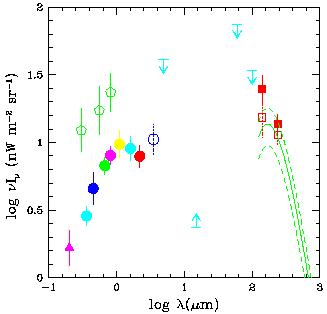


The contribution of known galaxies to the optical EBL can be calculated
directly by integrating the emitted flux times the differential number counts
down to the detection threshold. I have used the compilation of ground-based,
HST, and HDF data shown in
Figure 1 to compute the integrated flux
at 0.35 

 2.2 µm.
2.2 µm.
In all seven bands, the slope of the differential number-magnitude relation is
flatter than 0.4 above mAB ~ 20 (25) at near-IR (optical)
wavelengths, and this flattening appears to be more pronounced at the shorter
wavelengths. The leveling off of the counts is clearly seen in
Figure 1, where the function
i =
10-0.4(mAB+48.6) N(m) is plotted
against apparent magnitude in
all bands. While counts having a logarithmic slope d log N /
dmAB =
=
10-0.4(mAB+48.6) N(m) is plotted
against apparent magnitude in
all bands. While counts having a logarithmic slope d log N /
dmAB = 
 0.40 continue to add to the EBL at
the faintest magnitudes, it
appears that the HDF survey has achieved the sensitivity to capture
the bulk of the near-ultraviolet, optical, and near-IR extragalactic light
from discrete sources. The flattening at faint
apparent magnitudes cannot be due to the reddening of distant sources as
their Lyman break gets redshifted into the blue passband,
since the fraction of Lyman-break
galaxies at (say) B
0.40 continue to add to the EBL at
the faintest magnitudes, it
appears that the HDF survey has achieved the sensitivity to capture
the bulk of the near-ultraviolet, optical, and near-IR extragalactic light
from discrete sources. The flattening at faint
apparent magnitudes cannot be due to the reddening of distant sources as
their Lyman break gets redshifted into the blue passband,
since the fraction of Lyman-break
galaxies at (say) B  25 is only of order 10%
[32].
Moreover, an absorption-induced loss of sources cannot explain the similar
change of slope in the V, I, J, H, and K bands.
While this suggests that the surface density of
optically luminous galaxies is leveling off beyond z ~ 1.5, one should
worry about the possibility of a significant amount of light being missed
at faint magnitudes.
25 is only of order 10%
[32].
Moreover, an absorption-induced loss of sources cannot explain the similar
change of slope in the V, I, J, H, and K bands.
While this suggests that the surface density of
optically luminous galaxies is leveling off beyond z ~ 1.5, one should
worry about the possibility of a significant amount of light being missed
at faint magnitudes.

|
Figure 2. Spectrum of the optical extragalactic background light from resolved sources as derived from a compilation of ground-based and space-based galaxy counts in the UBVIJHK bands (filled dots), together with the FIRAS 125-5000 µm (solid and dashed lines) and DIRBE 140 and 240 µm (filled squares) detections [19], [15]. The empty squares show the DIRBE points after correction for WIM dust emission [20]. Also plotted (filled triangle) is a FOCA-UV point at 2000 Å [1], and a tentative detection at 3.5 µm (empty dot) from COBE/DIRBE observations [7]. The empty pentagons at 3000, 5500, and 8000 Å are recent detections from absolute photometry [3]. Upper limits are from [19], the lower limit from [10]. Note that the values obtained by integrating the brightness of resolved galaxies are strict lower limits to the EBL intensity. |
The spectrum of the optical EBL
is shown in Figure 2, together with the recent
results from COBE.
The value derived by integrating the galaxy counts down to very
faint magnitude levels (because of the flattening of the number-magnitude
relation most of the contribution to the
optical EBL comes from relatively bright galaxies)
implies a lower limit to the EBL intensity in the 0.2-2.2 µm
interval of Iopt
 15
n W m-2 sr-1. Including the tentative
detection at 3.5 µm by
[7] would boost
Iopt to
15
n W m-2 sr-1. Including the tentative
detection at 3.5 µm by
[7] would boost
Iopt to  19
n W m-2 sr-1.
Recent estimates of the optical EBL at 3000, 5500, and 8000 Å
from absolute surface photometry by
[3] lie between a
factor of two to three higher than the integrated light from
galaxy counts. Applying this correction factor to the range 3000-8000 Å
gives an optical EBL intensity in excess of 25 n W m-2
sr-1 in the interval 0.2-3.5 µm. The COBE/FIRAS
[15]
measurements yield IFIR
19
n W m-2 sr-1.
Recent estimates of the optical EBL at 3000, 5500, and 8000 Å
from absolute surface photometry by
[3] lie between a
factor of two to three higher than the integrated light from
galaxy counts. Applying this correction factor to the range 3000-8000 Å
gives an optical EBL intensity in excess of 25 n W m-2
sr-1 in the interval 0.2-3.5 µm. The COBE/FIRAS
[15]
measurements yield IFIR  14 n W m-2 sr-1 in the 125-2000
µm range. When combined with the DIRBE
[19],
[27],
[20]
points at 140 and 240 µm, one gets a far-IR
background intensity of IFIR(140-2000 µm)
14 n W m-2 sr-1 in the 125-2000
µm range. When combined with the DIRBE
[19],
[27],
[20]
points at 140 and 240 µm, one gets a far-IR
background intensity of IFIR(140-2000 µm)
 20 n W m-2 sr-1.
The residual emission in the 3.5 to 140 µm region is poorly
known, but it is likely to exceed 10 n W m-2 sr-1
[8].
A ``best-guess'' estimate to the total EBL intensity observed today is then
20 n W m-2 sr-1.
The residual emission in the 3.5 to 140 µm region is poorly
known, but it is likely to exceed 10 n W m-2 sr-1
[8].
A ``best-guess'' estimate to the total EBL intensity observed today is then
In the rest of my talk, I will adopt a reference value for the
background light associated with star formation activity
over the entire history of the universe of 50 I50
n W m-2 sr-1.
